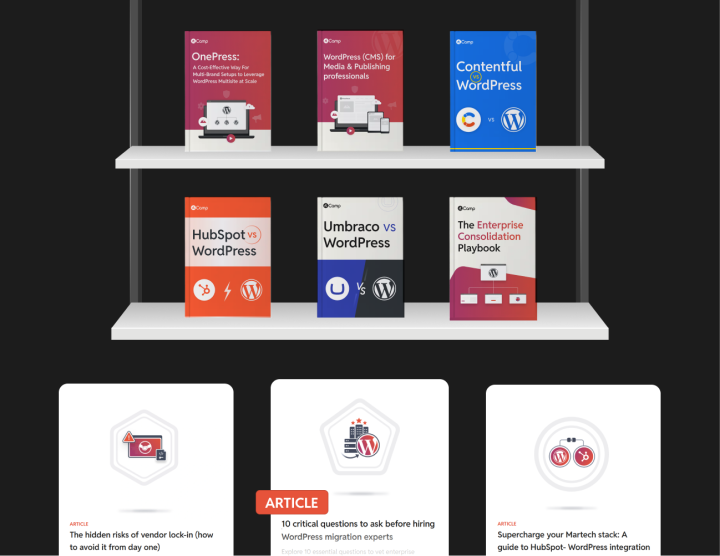Sanity CMS vs WordPress: The better headless CMS Solution
Agile Content Management Systems (CMS) have revolutionized the way organizations manage and deliver content. Inspired by the Agile Manifesto, which emphasizes adaptability and continuous improvement, agile CMSs bring the principles of agile development to content management. These systems are designed to meet the dynamic demands of modern digital environments, enabling you to create, collaborate, and deliver content more efficiently. We compare Sanity vs WordPress to show how these platforms address these challenges.
Benefits of an agile CMS
An agile CMS offers several key benefits that make it a superior choice for your content management:
- Better collaboration: Agile CMSs provide a single source of truth for content, enabling teams to collaborate more effectively. This reduces silos and ensures that all stakeholders are aligned.
- Faster production: With agile CMSs, content teams can work independently of development teams, allowing for quicker content production and deployment.
- Improved customer experience: Agile CMSs enable personalized content delivery across multiple channels, enhancing the overall customer experience.
- Transparent decision-making: Agile CMSs offer transparent workflows and content histories, fostering accountability and making it easier to track changes.
- Future-ready tech stack: Agile CMSs are composable, allowing organizations to adopt new technologies quickly without the need for expensive content migrations.
A headless CMS vs an agile CMS (and why an agile CMS is better)
While headless CMSs have gained popularity for their flexibility in content delivery, they often lack the collaborative and iterative features that make agile CMSs superior. A headless CMS focuses on decoupling the front-end and back-end, which is great for technical flexibility but doesn’t inherently support the agile workflows that content teams need.
An agile CMS, on the other hand, not only provides the technical flexibility of a headless CMS but also integrates tools for collaboration, planning, and iterative content development. This makes it a more comprehensive solution when you need to adapt quickly to changing market demands.
WordPress: The superior agile CMS
When it comes to choosing between WordPress vs Sanity for an agile CMS, WordPress stands out as the better solution. Here’s why:
Ease of use for creators
WordPress is renowned for its user-friendly interface, making it easy for creators to produce content without needing extensive technical knowledge. The Gutenberg block editor, for example, provides a visual editing experience that allows users to create complex layouts with ease. Sanity, while powerful, requires more technical expertise and lacks the intuitive interface that WordPress offers.
Developer community and extensibility
WordPress boasts the largest ecosystem of plugins, themes and integrations, making it highly extensible. The platform’s extensive talent pool—including freelancers, agencies, and enterprise-level development experts—further enhances its appeal. Developers can easily find pre-built solutions for almost any feature they need, reducing development time and costs.
In addition, you can also benefit from working with seasoned agencies like rtCamp (us), who specialize in crafting tailored WordPress solutions for complex business needs. In contrast, Sanity, has a more niche developer community. This limits the availability of pre-built solutions and increases reliance on in-house or specialized developers for customization.
Flexibility and hybrid delivery
WordPress offers both traditional and decoupled (headless) delivery options, known as “hybrid headless.” This flexibility allows organizations to choose the best approach for their needs, whether they prioritize ease of use for creators or technical flexibility for developers. Sanity, while focused on headless delivery, doesn’t offer the same level of hybrid flexibility.
Enterprise commerce
WordPress integrates seamlessly with enterprise commerce platforms, enabling organizations to create compelling content that drives customer engagement and sales. With a vast array of plugins and integrations, WordPress makes it easy to customize commerce experiences without sacrificing agility. Sanity, while capable, doesn’t have the same depth of commerce integrations as WordPress.
Content analytics and optimization
WordPress provides powerful content analytics and optimization tools, allowing creators to measure the impact of their content and make data-driven decisions. Plugins like Google Analytics and WooCommerce provide deep insights into content performance, helping organizations optimize their strategies. Sanity, while offering analytics, doesn’t have the same level of integration with popular analytics tools.
Infrastructure and security
Managed WordPress hosting (like WordPress VIP and Pagely) offer a robust infrastructure that can handle high traffic and spikes without compromising performance. With a cloud-based containerized infrastructure and a built-in CDN, managed hosting ensures fast and reliable content delivery. Security is also a priority, with features like automated code scanning and FedRAMP certification. Sanity, while secure, doesn’t have the same level of enterprise-grade infrastructure as managed hosting with WordPress.
In context of Sanity CMS vs WordPress, WordPress emerges as the better choice in your quest for an agile CMS solution. WordPress’ ease of use, extensive developer community, hybrid delivery options, enterprise commerce capabilities, robust analytics and superior infrastructure make it the ideal platform for agile content management.
Now checkout SnapWP🫰
Do explore how our SnapWP solution streamlines your content delivery, allowing you to effortlessly adapt and reuse content across multiple frontends. Whether you’re a marketer, developer, or content creator, WordPress provides the tools and flexibility you need to thrive in today’s fast-paced digital landscape.







